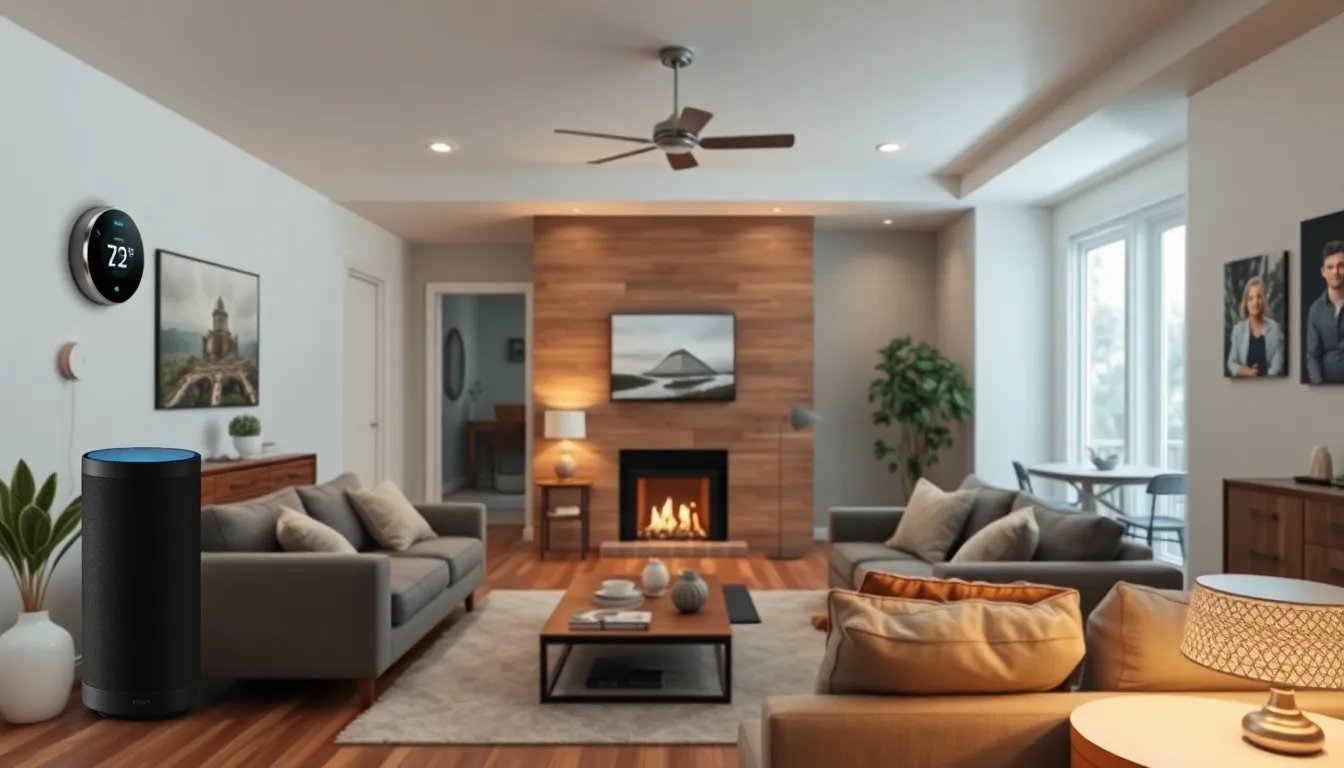Table of Contents
ToggleImagine walking into your home and having the lights dim to your favorite setting while your favorite playlist starts playing—no magic wands required. Home automation systems have transformed the way people interact with their living spaces, making life not just easier but a lot more fun. From controlling the thermostat with a simple voice command to ensuring your coffee brews just as you wake up, these systems are like having a personal assistant who never takes a day off.
Overview of Home Automation Systems
Home automation systems integrate various smart devices to create a cohesive and efficient living environment. Key components often include smart lighting, security cameras, and climate control systems. These devices communicate over a central hub, offering seamless control through mobile apps or voice commands.
Smart lighting systems allow homeowners to adjust brightness and color temperatures to match their mood or time of day. Voice-controlled thermostats optimize energy usage by learning individual preferences, maintaining comfort while reducing utility bills. Automated coffee makers can start brewing at a preset time, ensuring fresh coffee is ready every morning.
Home security becomes more robust with automated systems. Smart door locks provide keyless entry, while motion sensors send alerts if unusual activity is detected. Video doorbells enable homeowners to monitor visitors remotely and communicate through built-in cameras and microphones.
Energy efficiency stands as a significant benefit of home automation. Smart plugs can manage energy consumption by allowing users to turn off devices remotely. Systems that monitor usage over time help identify patterns, facilitating targeted adjustments for better efficiency.
Incorporating home automation improves convenience, security, and energy savings. Customization options mean that homeowners can tailor the system to fit their specific needs. These systems not only enhance the day-to-day experience but also increase the home’s value, making them a worthwhile investment.
Benefits of Home Automation

Home automation systems offer several advantages that significantly improve daily life. These benefits include convenience, energy efficiency, and enhanced security, which collectively transform homes into smarter living spaces.
Convenience and Comfort
Convenience emerges as a primary benefit of home automation. With voice-activated devices, individuals can adjust settings without manual effort. Smart lighting allows homeowners to create ambiance effortlessly, changing colors or brightness with simple commands. Automated coffee makers prepare fresh brews at desired times. Personalized routines can also streamline daily tasks, resulting in more free time for leisure activities.
Energy Efficiency
Energy efficiency ranks high among the advantages of home automation. Smart thermostats adapt heating and cooling based on occupancy and preferences, significantly reducing energy consumption. Automated energy monitors track usage patterns, providing insights that lead to smarter energy decisions. Smart plugs also help manage energy waste by allowing users to schedule when devices are on or off, leading to lower utility bills.
Enhanced Security
Enhanced security remains a crucial benefit of home automation systems. Smart door locks provide remote access control, allowing homeowners to secure their premises from any location. Motion sensors alert individuals to unusual activity, ensuring prompt responses to potential security threats. Additionally, security cameras integrated into the system offer real-time monitoring and recording, contributing to overall peace of mind.
Key Features to Consider
Consider several key features when selecting a home automation system. These aspects enhance functionality and usability for everyday needs.
Compatibility with Smart Devices
Compatibility with various smart devices ranks high among the features to assess. The system should support popular brands and devices, ensuring seamless integration of components like smart lights, speakers, and cameras. A wide range of connections maintains versatility, allowing users to expand their home automation setups effortlessly. When examining compatibility, establish device requirements beforehand to avoid future limitations.
User Interface and Control Options
User interface and control options significantly affect the home automation experience. An intuitive interface simplifies operation, making it easy for users to navigate settings. Favor systems offering multiple control methods such as mobile apps, voice commands, and physical remotes. Accessible interfaces enhance user experience, providing clear options to manage every aspect of the home easily. Reviewing the interface features ensures suitability for all household members.
Customization and Automation
Customization and automation features enable tailored experiences within home automation systems. Opt for systems that allow users to create unique routines, ensuring adaptability for individual needs. Scheduling functionalities automate daily tasks like adjusting lighting or regulating temperature, enhancing convenience. Comprehensive customization capabilities lead to optimized energy usage and personalized living conditions. A focus on these features ensures systems cater to specific preferences efficiently.
Top Home Automation Systems
Home automation systems offer a range of features, enhancing daily living experiences through technology. Below are three leading systems known for their excellent performance and versatility.
System A: Features and Performance
System A excels in compatibility, integrating seamlessly with over 1,000 smart devices. Users appreciate features such as remote access and robust voice control capabilities. Performance metrics indicate low latency, ensuring quick response times for commands. Automation options allow for scheduling routines, maximizing energy efficiency. In addition, customizable settings provide tailored experiences for users, enhancing overall convenience.
System B: Features and Performance
System B stands out with its user-friendly interface and extensive device support. Several smart home products work harmoniously within this ecosystem, promoting ease of use. Advanced security features, including real-time alerts and video surveillance integration, cater to safety needs. Users benefit from analytics monitoring, which tracks energy consumption patterns. Adjustable settings for lighting and climate control help create an optimized living environment.
System C: Features and Performance
System C offers innovative technology with a strong focus on sustainability. This system provides smart energy management, reducing consumption through real-time insights. Users find high customization options, allowing unique automation setups tailored to their lifestyles. Enhanced integration with home security devices strengthens overall safety. The intuitive app enhances user experience by providing centralized control over various devices.
Choosing the Right System for You
Selecting the right home automation system involves evaluating personal preferences and priorities to enhance daily life. Various factors play a role in this decision-making process.
Assessing Your Needs
Identifying specific needs helps narrow down options. Consider the number of devices requiring integration, such as smart lights, security cameras, and climate controls. Determine whether priority lies in security enhancements or energy management. Increased energy efficiency aligns with eco-conscious lifestyles. Users seeking convenience may prioritize voice control and automation routines. Assessing long-term goals aids in choosing systems that accommodate future upgrades and expansions.
Budget Considerations
Establishing a budget ensures choices remain practical. Systems vary in price, from basic setups to comprehensive solutions. Initial costs include hardware and installation, while ongoing expenses might cover subscription services or device maintenance. Balancing affordability with desired features is crucial. Opting for systems with flexible pricing models allows users to invest in premium features over time. Analyzing potential energy savings can also offset costs, making automation financially viable in the long run.
Investing in a home automation system transforms daily living into a more convenient and efficient experience. With a range of smart devices working in harmony, homeowners can enjoy enhanced security and energy savings while simplifying their routines.
Choosing the right system involves understanding personal needs and preferences, ensuring compatibility and usability. By focusing on key features and budget considerations, individuals can find a solution that not only meets their requirements but also elevates their home’s overall value. Embracing home automation is a step towards a smarter and more connected lifestyle.


